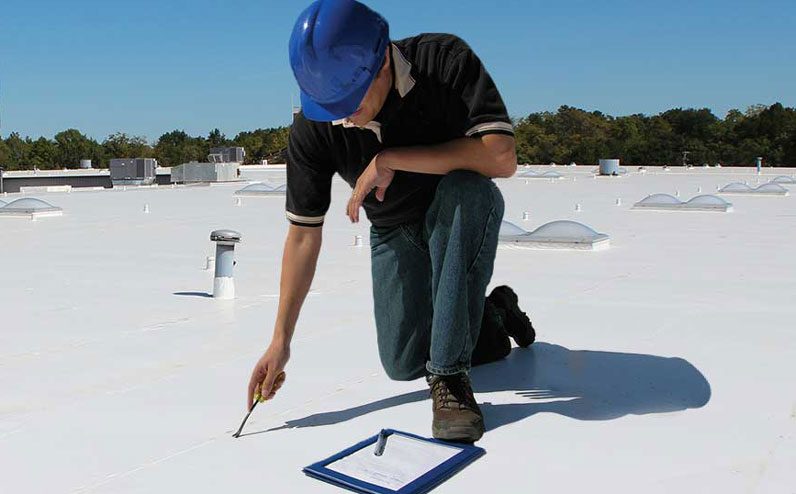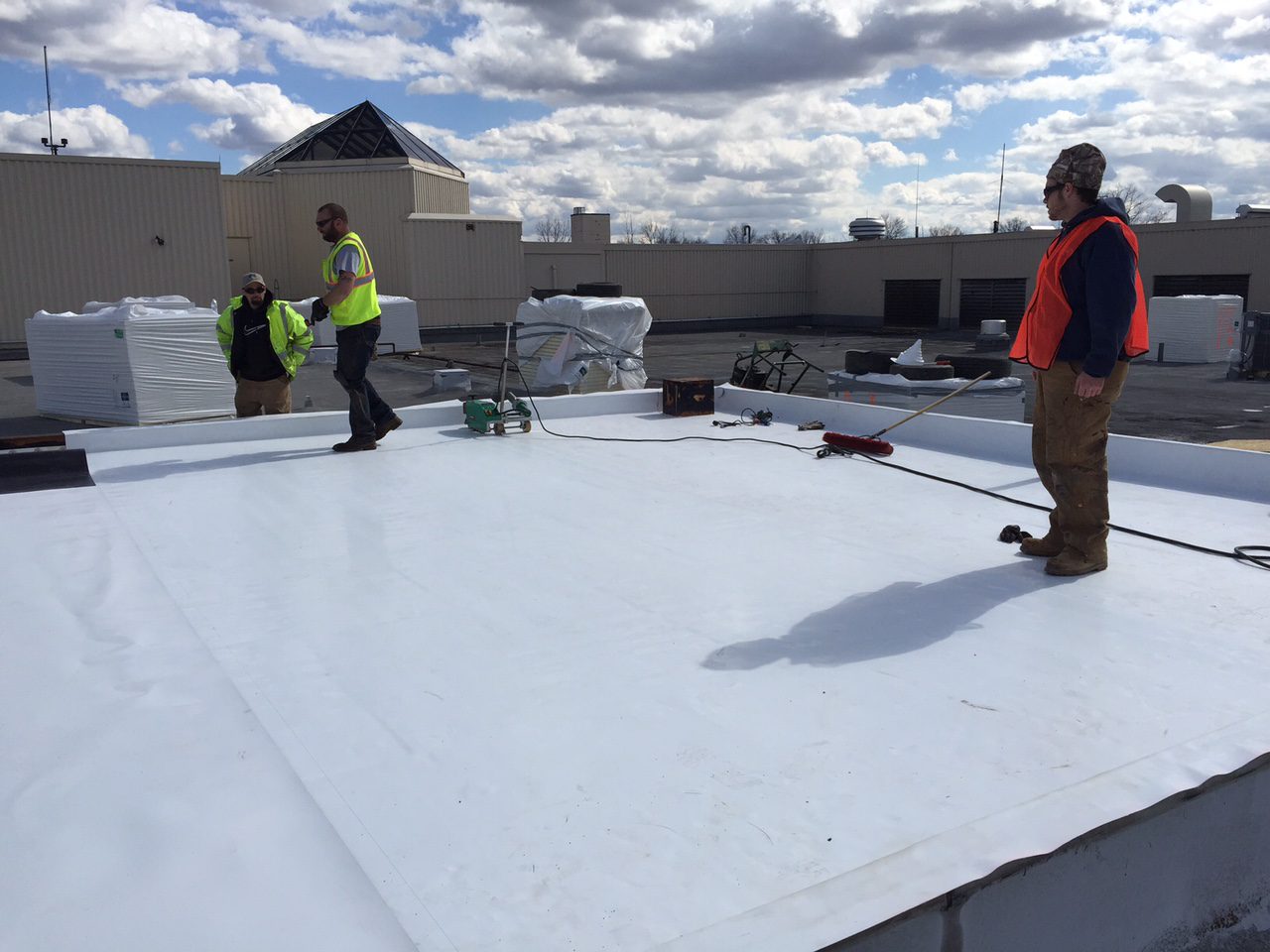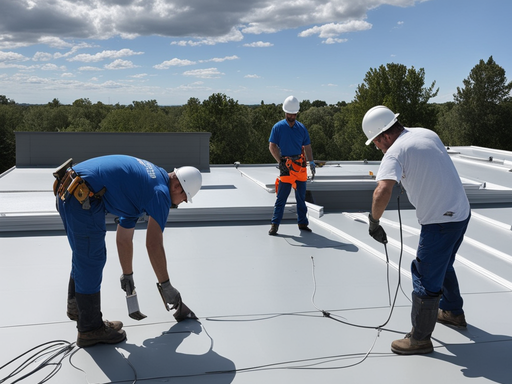Learn why TPO is a highly regarded roofing system within the industry and about the many benefits it brings to property owners.
Saving money and energy becomes easier with the help of TPO roofing. Reduce your monthly utility bills after professional installation of this eco-friendly roofing system on your building.
What Is TPO Roofing?
Thermoplastic polyolefin, better known as TPO, is a single-ply reflective roofing membrane. Made of polypropylene and ethylene-propylene, which are different types of rubber infused or polymerized together, this solution is used to cover flat commercial roofs. TPO is produced with fillers as well, including talc, fiberglass, carbon fiber, wollastonite, and synthetics.
Essentially, TPO roofing material is composed of three parts:
- TPO polymer base (top layer)
- Polyester, which is reinforced fabric or scrim (middle layer)
- TPO compounded pinnacle ply (bottom layer)
TPO roofing membranes have a range of thickness, available in 45 mil, 60 mil, and 80 mil. Flat TPO roofing systems have multiple installation options, too—customers can choose to have TPO adhered to the roof mechanically or attached with screws and plates. Depending on your budget and building requirements, TPO can be a great option for your commercial property for several reasons.

Benefits of TPO Roofing
TPO roofing systems have similar properties and advantages of other synthetic, rubber roofing materials like PVC (polyvinyl chloride) and EPDM (ethylene propylene diene terpolymer). However, on the upside, TPO is less expensive. For this reason, TPO roofing systems are gaining popularity within the building and construction industry. Other benefits of TPO roofing include:
Energy Efficiency
TPO roofs are designed to reflect the sun’s rays. Since TPO is manufactured in gray, white, and tan, it’s featured by the Cool Roof Rating Council. During the summer, TPO roofing systems help reduce utility bills, since they keep the building cooler than other roofing types. The roof’s surface reflects UV rays into the environment. Therefore, the roof doesn’t overheat and raise the temperature indoors. Thanks to the white reflective surface, TPO roofing materials also meet the EPA’s ENERGY STAR requirements.
Durability
Although TPO is lightweight and flexible, it’s also strong and long lasting. TPO roofing’s UV reflective properties slow the process of degradation from thermal shock, which is the constant expansion and contraction of the roof’s surface due to extreme temperatures. TPO is also water resistant and does not easily puncture or tear. A TPO roofing system offers your commercial building at least 20 years of protection.

Simple Installation
The installation process for TPO is fast and convenient, thanks to large, lightweight sheets of roofing membrane. Wider sheets mean fewer seams are required. Plus, because TPO is quick and easy to apply, property owners pay less for installation.
Versatility
While TPO is commonly used for commercial roofing, it’s also suitable for residential properties. Plus, TPO membranes come in an array of colors, including black and light gray to meet customers’ preferences. Regardless of the selected color, TPO roofing material is UV resistant, but the color should be selected according to your region and your area’s usual climate and weather conditions.
For those who live in colder regions, it’s wise to select TPO in black or gray, so it has better sun ray retention. Since the building absorbs more heat from the sun, come wintertime, you won’t need to set your thermostat too high to keep your building at a comfortable temperature. Conversely, lighter-colored roofs reflect sunlight and help buildings stay comfortably cool in the summer without having to turn the AC on full blast. Save money on your energy bills by choosing the optimal roofing color for your climate.
How Is TPO Roofing Installed?
Versatile TPO roofing systems give property owners the benefit of choice. Customers can choose how their TPO Roofing System is installed, whether with adhesives or direct fastening to secure the roof deck. During installation, a team of roofers lays out an insulation membrane with no gaps greater than 1/4 inch. Then the TPO layers are added to the surface, with a thickness of at least 1 1/2 inches or more.
Next, the TPO membrane is accurately measured to meet the parameters of the roof. Then, the TPO is mechanically attached to the roof’s surface, meaning special equipment and tools are required. With an automatic heat welding machine and heat fastening plates, roofers affix the TPO and give it a seamless finish. With proper installation, TPO roof repair is rarely needed, so it’s important to hire professionals to complete the job.

Costs of TPO Roofing
TPO roofing costs between $5 to $7 per square foot. The price for a 1,500-square-foot flat roof installation varies depending on the material used. For rubber TPO roofs, the following is factored into the final cost:
- Roof condition
- Roof size
- Roof access
- Roof protrusions or penetrations
- Insulation options
- Membrane selection (thickness)
- Warranty options
Choose a Roofing Company You Can Trust
Look no further than Alpha Commercial Roofs for all your roofing needs. Our team of professional and experienced workers will ensure that you have the best roof to combat any situation.
Contact us today at 855-862-7663





